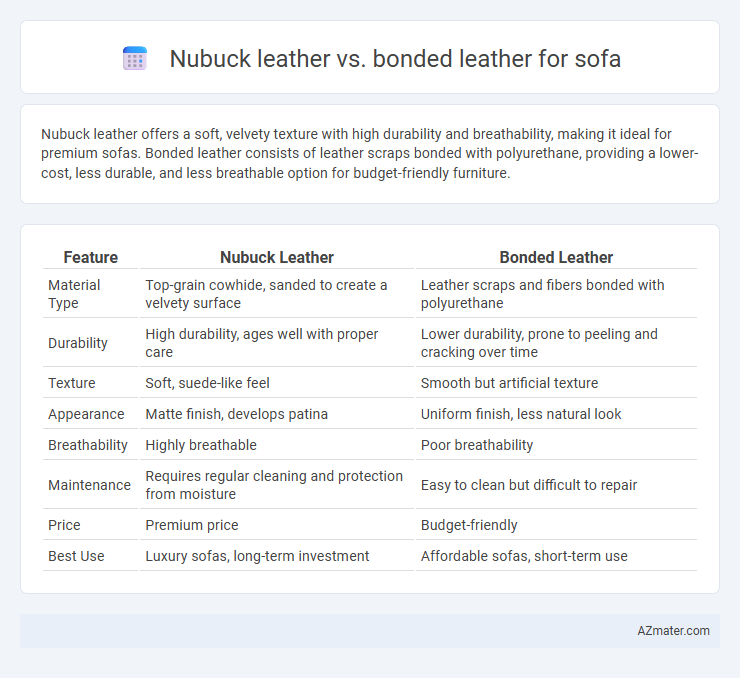Nubuck leather offers a soft, velvety texture with high durability and breathability, making it ideal for premium sofas. Bonded leather consists of leather scraps bonded with polyurethane, providing a lower-cost, less durable, and less breathable option for budget-friendly furniture.
Table of Comparison
| Feature | Nubuck Leather | Bonded Leather |
|---|---|---|
| Material Type | Top-grain cowhide, sanded to create a velvety surface | Leather scraps and fibers bonded with polyurethane |
| Durability | High durability, ages well with proper care | Lower durability, prone to peeling and cracking over time |
| Texture | Soft, suede-like feel | Smooth but artificial texture |
| Appearance | Matte finish, develops patina | Uniform finish, less natural look |
| Breathability | Highly breathable | Poor breathability |
| Maintenance | Requires regular cleaning and protection from moisture | Easy to clean but difficult to repair |
| Price | Premium price | Budget-friendly |
| Best Use | Luxury sofas, long-term investment | Affordable sofas, short-term use |
Introduction to Nubuck and Bonded Leather
Nubuck leather is a top-grain cowhide sanded on the outer side to create a velvety surface, known for its durability, softness, and distinctive texture ideal for luxury sofas. Bonded leather is manufactured from shredded leather fibers bonded with polyurethane or latex, offering an economical and uniform finish but generally less durable and breathable. Choosing between Nubuck and bonded leather affects sofa longevity, appearance, and comfort based on material composition and treatment.
What is Nubuck Leather?
Nubuck leather is a premium material made from the outer side of a hide, sanded or buffed to create a soft, velvety texture that enhances its luxurious appearance and durability. Unlike bonded leather, which consists of leather scraps bonded together with polyurethane or latex, nubuck retains the strength and breathability of genuine full-grain leather, making it highly resistant to wear and tear in sofas. This natural material also allows better aging and patina development, providing a unique aesthetic that improves with time.
What is Bonded Leather?
Bonded leather is a material made by combining shredded leather fibers with polyurethane or latex binders, then pressing them onto a fabric backing, offering an affordable alternative to genuine leather. Unlike Nubuck leather, which is top-grain leather sanded to create a soft, velvety surface, bonded leather lacks the natural durability and breathability of full or top-grain leathers. Bonded leather provides a uniform look but tends to wear and peel faster, making it less suitable for long-lasting sofas compared to Nubuck.
Appearance and Texture Comparison
Nubuck leather showcases a velvety, matte finish with a soft, suede-like texture achieved by sanding the outer grain, offering a luxurious and natural appearance for sofas. Bonded leather consists of leather scraps bonded with polyurethane and stamped with a synthetic grain, resulting in a smoother but less breathable surface that can feel more artificial and uniform. The durability and tactile sensation of nubuck make it more premium, while bonded leather offers budget-friendly options with easier maintenance but lacks the rich texture and authenticity of nubuck.
Durability and Longevity
Nubuck leather offers superior durability and longevity for sofas due to its top-grain cowhide composition, which is naturally resistant to wear, scratches, and aging. Bonded leather, made from leftover leather scraps combined with polyurethane or latex, tends to wear out faster, showing peeling and cracking within a few years of regular use. Investing in nubuck leather ensures a more resilient and long-lasting sofa, making it ideal for high-traffic living spaces.
Comfort and Feel
Nubuck leather offers a soft, velvety texture with a breathable surface that enhances comfort and provides a natural, luxurious feel ideal for sofas. Bonded leather, made from shredded leather fibers combined with polyurethane, feels less supple and tends to be stiffer and less breathable, which may reduce overall seating comfort. The durability and plushness of Nubuck make it a preferred choice for those seeking a premium, comfortable sofa experience.
Maintenance and Cleaning Requirements
Nubuck leather requires gentle maintenance with specific leather cleaners and conditioners to preserve its soft, velvety texture and resist staining, while avoiding water exposure that can cause damage. Bonded leather, composed of real leather fibers mixed with polyurethane, is easier to clean using mild soap and water or leather wipes, but it may peel or crack over time if not properly maintained. Regular dusting and immediate spill cleanup are essential for both materials to extend the sofa's lifespan and maintain appearance.
Cost Differences
Nubuck leather sofas typically command higher prices due to the meticulous sanding process that produces their soft, velvety texture, reflecting premium quality and durability. Bonded leather, made by bonding shredded leather scraps with polyurethane, offers a budget-friendly alternative but lacks the longevity and natural appeal of nubuck. The cost difference between nubuck and bonded leather sofas can be significant, with nubuck often costing double or more per square foot, impacting overall furniture investment.
Environmental Impact
Nubuck leather, derived from the outer layer of animal hide, is biodegradable and has a lower environmental footprint due to minimal chemical processing compared to bonded leather. Bonded leather is made from leather scraps mixed with synthetic fibers and adhesives, resulting in higher emissions and non-biodegradable waste during production. Choosing nubuck reduces chemical pollution and supports sustainable leather sourcing, whereas bonded leather contributes to landfill waste and environmental degradation.
Which Sofa Leather Should You Choose?
Nubuck leather, known for its soft texture and durability, offers a luxurious feel and ages gracefully, making it ideal for high-end sofas that demand comfort and longevity. Bonded leather, composed of leather scraps bonded with polyurethane, is more affordable but less durable and prone to peeling over time, suitable for budget-conscious buyers seeking a leather-like appearance. Choose Nubuck for premium quality and a natural look, while Bonded leather fits better in short-term or low-traffic sofa use where cost-efficiency is a priority.

Infographic: Nubuck leather vs Bonded leather for Sofa
 azmater.com
azmater.com